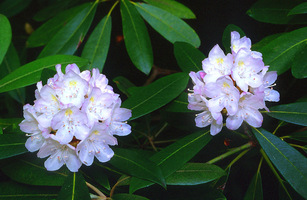
The rhododendron maximum, more commonly called great rhododendron or big laurel, was designated the official state flower of West Virginia, January 23, 1903, after being recommended by the governor and voted on by students in the public schools. The name comes from the Greek rhodo, meaning ’’rose’’ and dendron, meaning ‘‘tree.’’
Throughout the world there are more than 800 species of rhododendron, the most abundant being the purple or Catawba rhododendron and rhododendron maximum, also known as great laurel or rosebay. The rosebay alternates growth years with blooming years. The range of the rhododendron in the United States is in the eastern and midwestern states. It is common in much of West Virginia, the massed plants putting on a spectacular show when in full bloom.
The rhododendron maximum, from the family Ericaceae, is found in wet woods and swamps and is characterized by white, pink, or purple flowers, with orange or green spots and sticky flower stems. The rhododendrons are evergreens, with leaves that are leathery and smooth. The height of this plant can be from five to 40 feet, with flowering in June and July. The leaves are poisonous to cattle and deer.
The family Ericaceae includes heaths and heathers, and like them, the rhododendron requires moist, well-drained soil. If the plant has the right soil, moisture, and drainage, it requires little else. The rhododendron is efficient at extracting the nutrients it needs from acid soil. Rhododendrons are often used in landscaping and there are many hybrids. The hard wood of this plant is used for tool handles and is a favorite of craftspeople for making walking sticks and furniture. Its well-shaped forks make excellent slingshots.
This Article was written by Christine D. Fenn
Last Revised on January 24, 2018
Cite This Article
Fenn, Christine D. "Rhododendron." e-WV: The West Virginia Encyclopedia. 24 January 2018. Web. 21 October 2024.


Comments?
So far, this article has 2 comments.
Click here to read and contribute to the discussion →